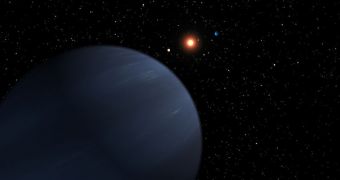Astronomers have believed for a long time that, as technology finally progresses, we will soon be able to detect habitable worlds around stars similar to our own Sun. While the technology has not yet matured to that point, it is still advanced enough to provide a taste of the things to come. Recently, experts were able to infer the existence of four new exoplanets of the super-Earth class, all of them around two stars that were almost identical to the Sun. The solar systems are relatively close by.
The four celestial bodies were identified by combining astronomical data collected by experts at the Hawaii, US-based W. M. Keck Observatory, and the Anglo-Australian Telescope (AAT), in New South Wales, Australia. While the planets were not imaged directly with the telescope, their presence was inferred from the influence they exerted on their parent stars. This method of detection is the one most commonly used by astrophysicists to determine the existence of new exoplanets, and its scientific name is the radial velocity (wobble) technique, Space reports.
“These detections indicate that low-mass planets are quite common around nearby stars. The discovery of potentially habitable nearby worlds may be just a few years away,” University of California in Santa Cruz (UCSC) Professor of Astronomy and Astrophysics Steven Vogt, also a member of the study team, says. He explains that three out of the new super-Earths were found around the star 61 Virginis, which lies relatively close by, some 28 light-years away. This class of exoplanets is characterized by the fact that its members are a lot larger than the Earth, but smaller than Uranus or Neptune.
The science group was even able to estimate the relative mass of the three exoplanets around our neighboring star. University of New South Wales expert Chris Tinney, also a member of the research team, says that 61 Vir b has about 5.1 Earth masses, 61 Vir c has 18 Earth masses, and that 61 Vir d is equivalent to 23 times the mass of our planet. “So the smallest one is in the super-Earth mass range, and is the first planet like this to be found around a Sun-like star,” Tinney says.
The fourth exoplanet was discovered around another close star, HD 1461, which lies some 76 light-years away from us, in the direction of the constellation Cetus. The planet, dubbed HD 1461b, is only 7.3 times the mass of the Earth, and researchers say that they have not yet been able to identify its composition. It may be that it contains largely rock and iron, such as our planet does, or that it's made mostly of gas, such as our solar system's gas giants.
“This is exciting, because it demonstrates the ability of our team to find planets at these interesting, small masses around solar-mass stars. If we want to one day find habitable planets that are really like the Earth in systems that are really like ours, then those are the sorts of stars we need to be able to find low-mass planets around,” Tinney concludes.

 14 DAY TRIAL //
14 DAY TRIAL //